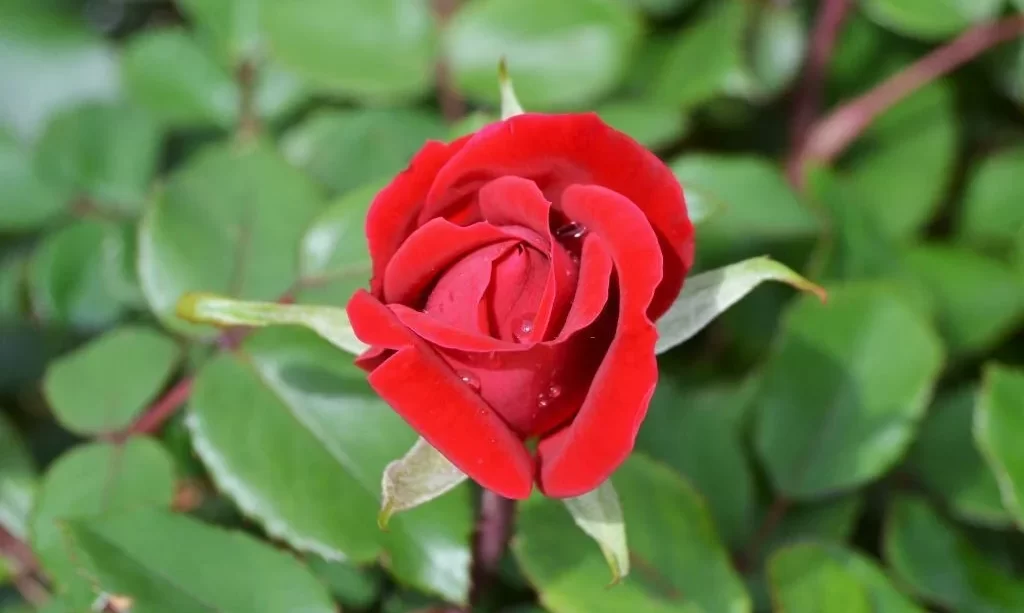Roses, with their timeless elegance and enchanting fragrance, have been cherished as symbols of love, beauty, and sentiment for centuries. A key aspect of the allure of roses lies in their unfolding beauty, but have you ever wondered what time roses open? The timing of a rose’s bloom is a captivating phenomenon, with multiple factors at play. Understanding the intricate process of when roses open can deepen your appreciation for these iconic flowers. In this exploration, we will delve into the various factors that influence the timing of a rose’s bloom, shedding light on the mystery of when and how these magnificent flowers reveal their splendor.
- Large, double red blooms
- USDA zones 5-11
- Plant will ship dormant if ordered mid-fall to mid-spring
- Deciduous – loses its leaves during the winter months
- Water twice per week until established, then water once per week
Factors Affecting Rose Blooming Time
The precise moment when a rose opens its petals is influenced by an interplay of several factors, each contributing to the delicate dance of blossoming. Here are the key factors to consider:
- Rose Variety: Different rose varieties have their unique blooming patterns. Some roses may open early in the morning, while others take their time and unfurl their petals later in the day. The specific variety you’re observing will play a significant role in determining when it chooses to bloom.
- Environmental Conditions: Roses are attuned to their environment. Temperature, humidity, and sunlight are crucial determinants of when roses open. Warmer conditions often encourage roses to open earlier, while cooler temperatures can delay the process. Adequate humidity levels also facilitate the blooming process.
- Time of Day: The time of day plays a pivotal role in the opening of rose blossoms. Many roses tend to reach their full splendor during the late morning to early afternoon, but the exact timing can vary. Some roses might start opening in the morning and continue throughout the day, while others prefer to unveil their beauty later.
These factors work in harmony to orchestrate the mesmerizing performance of a rose in bloom. Understanding them can enhance your experience of appreciating roses and provide insight into the intricate natural rhythms of these iconic flowers.
Rose Blooming Process
The blooming of a rose is a fascinating process, marked by distinct stages that ultimately culminate in a fully opened blossom. Here’s a breakdown of the rose blooming process:
- Bud Formation: It all begins with the formation of a tiny, tightly closed bud. At this stage, the petals are concealed within, and the bud remains small and compact.
- Bud Swelling: As the bud continues to develop, it undergoes a gradual swelling, causing it to take on a more rounded shape. The outermost petals begin to unfurl, hinting at the beauty concealed within.
- Bud Color Change: One of the most visually striking stages is when the bud’s color begins to change. Depending on the rose variety, this transformation can be subtle or dramatic. The bud starts to exhibit hints of the vibrant colors that will characterize the fully opened flower.
- Full Bloom: Finally, the moment arrives when the bud fully opens, revealing the breathtaking beauty of the rose in all its glory. The petals have expanded and unfurled to create the iconic and captivating rose bloom.
Variability Among Rose Varieties
One of the enchanting aspects of roses is the incredible diversity among rose varieties, and this diversity extends to their blooming patterns. Here’s how different rose varieties can exhibit distinct behaviors:
- Early-Blooming Roses: Some rose varieties are known for their early blooming tendencies. These roses might start opening in the morning or even before dawn, welcoming the day with their beauty.
- Late-Blooming Roses: On the other end of the spectrum, there are late-blooming rose varieties. These roses take their time, often waiting until the afternoon or later in the day to reveal their fully opened blooms. Their leisurely pace adds to the anticipation and allure of their blossoms.
The variability among rose varieties ensures that there’s a rose to suit every preference and occasion, whether you prefer the early risers or those that prefer to bask in the afternoon sun.
Environmental Factors
Environmental conditions play a pivotal role in dictating when roses open and how they progress through their blooming stages:
- Temperature: Roses are highly responsive to temperature. Warmer conditions typically encourage roses to bloom earlier, while cooler temperatures can delay the process. Extreme heat or cold can also affect the timing and quality of the blossoms.
- Humidity: Adequate humidity levels are essential for the health of rose blossoms. Dry conditions can cause petals to wither prematurely, while the right level of moisture can help the roses open fully and retain their freshness.
- Sunlight: Roses are phototropic, meaning they respond to light. They often begin opening their blossoms when exposed to natural light. However, direct sunlight can cause them to wilt more quickly, so they often prefer bright but indirect light.
These environmental factors interact dynamically, influencing when and how roses open. They underscore the intricate relationship between roses and their surroundings, making each rose’s bloom a unique and captivating event.
Time of Day
The time of day is a crucial factor in the enchanting performance of roses unfurling their petals. Here’s how the time of day influences the opening of rose blossoms:
- Late Morning to Early Afternoon: Many roses tend to reach their full splendor during the late morning to early afternoon. This is when the sunlight is ample but not too intense, creating the perfect conditions for roses to open their blossoms.
- Morning Unfurling: Some roses prefer to greet the day by opening their buds in the morning hours. These early risers gradually reveal their beauty as the sun rises, offering a delightful display to those who appreciate their morning ritual.
- Continuous Unveiling: Roses can have diverse schedules, with some starting to open in the morning and continuing to unfurl throughout the day. This gradual progression adds an element of anticipation, as you watch the bloom slowly transform.
How to Observe Rose Blooming Time
Observing the blooming time of roses can be a delightful and meditative experience. Here are some tips on how to fully appreciate this natural spectacle:
- Regular Monitoring: Keep a watchful eye on your rosebushes or cut roses in a vase. Check them at different times of the day to observe their changing stages.
- Document Changes: Consider taking photographs or keeping a journal to document the progression of your roses from bud to full bloom. This not only helps you appreciate the beauty but also allows you to track patterns among your rose varieties.
- Enjoy the Process: Take moments to sit beside your roses and witness the gradual opening of their blossoms. Appreciate the intricate details of each petal as it unfurls and the unique colors that emerge.
Conclusion
In the world of flowers, few are as enchanting and beloved as roses, and understanding the timing of when roses open adds an extra layer of wonder to their allure. The blooming of roses is an intricate dance influenced by various factors, including the rose variety, environmental conditions, and the time of day. Each rose variety has its own unique schedule, making the world of roses a captivating realm to explore.
As you observe the blooming time of roses, remember that it’s not just about the end result of a fully opened blossom but also about the journey and the ever-changing beauty that each stage brings. Whether you’re tending to a rose garden or simply enjoying a vase of freshly cut roses, the timing of their blooms is a reminder of nature’s artistry and the joy that flowers bring to our lives.





